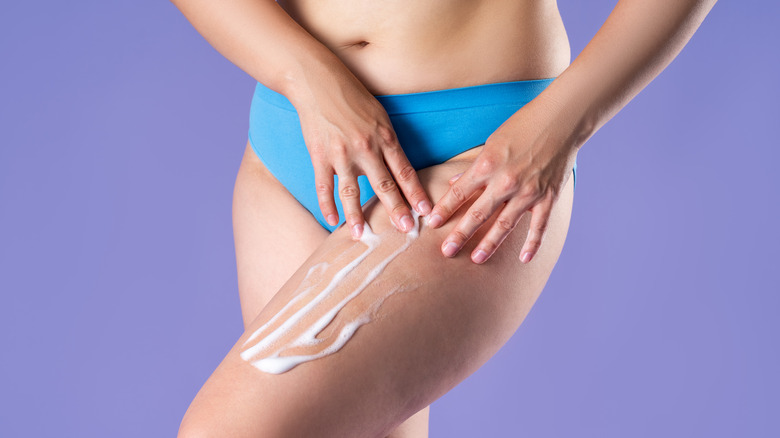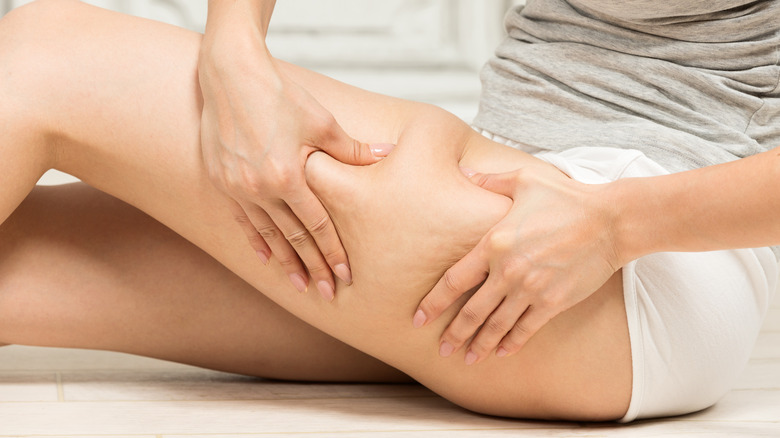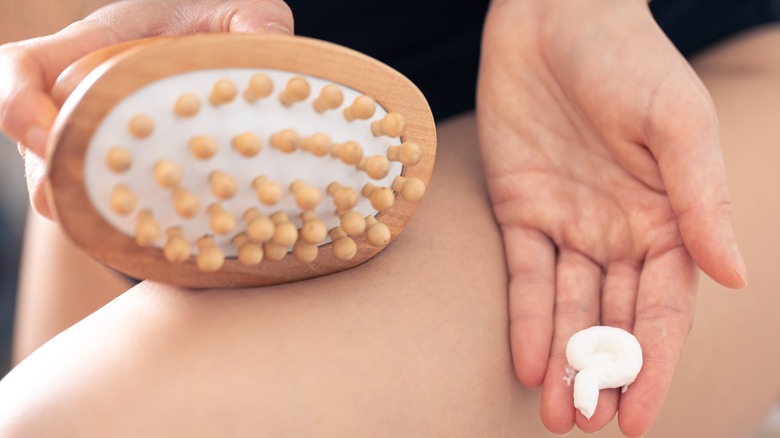Do Cellulite Removal Creams Actually Work?
We may receive a commission on purchases made from links.
Cellulite affects most women, with nearly nine out of 10 developing some level of the condition throughout their lives. Men aren't immune, either. Although their tissue structure makes them less susceptible to its appearance, they, too, can experience its effects, according to research from Plastic and Reconstructive Surgery. What's more, dermatologists from The Journal of The European Academy of Dermatology and Venerology have even proposed an official grading system to assess its severity. While some of us view the harmless skin condition with indifference, there are others who take a more offensive approach to it.
Those who have lived without cellulite are undoubtedly familiar with the term or its appearance, thanks to advertisers steadfastly marketing ways to remove it. You've surely seen creams and scrubs claiming to offer a reprieve from unwanted skin dimples, and there are even nutritional supplements and lifestyle regimens that tout the alleged power to combat it.
You might be curious about the validity of products asserting their ability to eradicate what some refer to as "orange peel skin." With thousands of anti-cellulite creams on the market, one would think there must be some truth to support their sales, but is that actually the case?
What is cellulite and why does it appear?
If you've ever heard of the belief that cellulite is caused by toxic wastes and buildup, it's simply not true. Although the tale is repeated often across the internet, it's been debunked by doctors who have examined the physical structure of cellulite. "The dimples that you see on hips, thighs, and buttocks are your basic, normal fat, but in an abnormally abundant supply," Dr. Gerald Imber told the Orlando Sentinel. Additional research by The International Journal of Cosmetic Science indicated that the appearance of cellulite is not only caused by fat but also by the presence of irregular connective tissue.
Considering the amount of attention it receives, it's surprising how misunderstood cellulite is. Research from The Journal of Cosmetic Dermatology proposed the theory that fluctuating estrogen levels can impact the development of cellulite, but the exact cause of the dimpled appearance is still not clear. As detailed by Cleveland Clinic, women and girls often experience exaggeration of cellulite dimples during puberty and pregnancy, which may also support the estrogen link. Other aspects like heredity, menopause, the passage of time, and the thickness of a person's skin influence both the development of cellulite and its prominence on the body.
What cellulite removal creams claim to do
According to WebMD, common ingredients in anti-cellulite creams purported as effective include caffeine, retinol, aminophylline, and theophylline, the latter of which is actually an asthma medication (per MedLine Plus). Some cellulite creams claim to stimulate cellular turnover and growth of new tissue, processes professed to fill in cellulite indentations, while other creams labeled as anti-cellulite cosmetics suggest that their proclaimed fat-eliminating and slimming effects will nip cellulite in addition to general fat on the body.
Some cellulite creams focus more on skin firming and hydration and contain essential oils designed to work in tandem with a massage. Certain brands even promise features like "sweat enhancement" that complement the effects of regular gym sessions. Vitamins, antioxidants, and plant-based materials can all play a role in these formulas. There are even options that are cruelty-free, vegan, and made without parabens or sulfates.
Do cellulite removal creams really work?
As far as the efficacy of products that purport to be miracle cures against cellulite, the answer isn't black and white. The reviews by users who believe that the creams do work aren't entirely wrong. Cellulite creams have the potential to help hydrate the skin, creating a fuller appearance that may "fill in" the uneven texture at first glance. However, the effects are temporary, and there is no cream that can remove or alter your fat cells. "Cellulite is a complex architectural disruption that is largely happening deep in the skin and you won't be able to penetrate that area with topical products," dermatologist Evan Rieder explained to The Strategist.
Should you pursue more intense cellulite treatments through medical-grade methods, the ingredients in topical anti-cellulite creams may support the results (via WebMD). Retinol-containing creams have produced subtle degrees of improvement in cellulite visibility when applied daily for at least six months, though the subtlety of results is stressed. Thus, options like Paula's Choice Retinol Skin-Smoothing Body Treatment might be worth exploring. Creams with caffeine and vitamins can also be complementary to stronger treatments, but once again don't go in expecting super noticeable results.
What else can you do to reduce the appearance of cellulite?
A study published in Skin Research and Technology uncovered that cellulite's appearance can be mitigated temporarily through the use of massage. This coincides with anecdotal reports that proper dry brushing, a form of skin massage, can be an effective, albeit temporary, treatment against cellulite. If anything, massage serves as an inexpensive alternative to creams that provide similar outcomes.
Recent cosmetic treatments, such as the injectable Qwo, have been released to combat cellulite in a more aggressive way, but patient reviews of the procedure are mixed. As one recipient of the Qwo treatment described to RealSelf, "[I] had the treatment to correct my cellulite dimples and ... I was left with depressions and fat/volume loss in my buttocks."
Cellulite may never fully disappear, but there's one simple way to help reduce its appearance from the inside out. According to a study from The International Journal of Medical Reviews, endurance training can aid in cellulite reduction by changing your body composition, but more research is needed to fully understand which forms of exercise can best treat cellulite.
Here's the bottom line: based on the evidence available, it seems that you're best off trying a combination of methods in your quest to vanquish cellulite, and working out is likely to be your most reliable bet. While creams might not eliminate cellulite, they can provide a subtle enhancement to complement other interventions.




